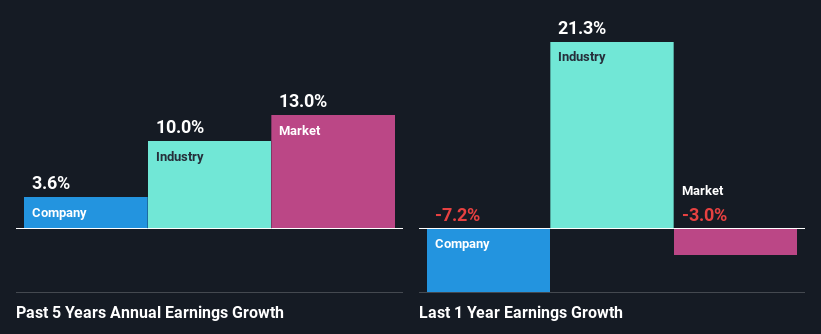Artesian Resources Corporation's (NASDAQ:ARTN.A) Stock Going Strong But Fundamentals Look Weak: What Implications Could This Have On The Stock?
Artesian Resources' (NASDAQ:ARTN.A) stock is up by a considerable 8.2% over the past week. However, in this article, we decided to focus on its weak fundamentals, as long-term financial performance of a business is what ultimately dictates market outcomes. In this article, we decided to focus on Artesian Resources' ROE.
Return on equity or ROE is an important factor to be considered by a shareholder because it tells them how effectively their capital is being reinvested. In short, ROE shows the profit each dollar generates with respect to its shareholder investments.
Check out our latest analysis for Artesian Resources
How Is ROE Calculated?
The formula for ROE is:
Return on Equity = Net Profit (from continuing operations) ÷ Shareholders' Equity
So, based on the above formula, the ROE for Artesian Resources is:
7.2% = US$17m ÷ US$230m (Based on the trailing twelve months to December 2023).
The 'return' is the profit over the last twelve months. So, this means that for every $1 of its shareholder's investments, the company generates a profit of $0.07.
What Is The Relationship Between ROE And Earnings Growth?
Thus far, we have learned that ROE measures how efficiently a company is generating its profits. Depending on how much of these profits the company reinvests or "retains", and how effectively it does so, we are then able to assess a company’s earnings growth potential. Assuming all else is equal, companies that have both a higher return on equity and higher profit retention are usually the ones that have a higher growth rate when compared to companies that don't have the same features.
A Side By Side comparison of Artesian Resources' Earnings Growth And 7.2% ROE
On the face of it, Artesian Resources' ROE is not much to talk about. A quick further study shows that the company's ROE doesn't compare favorably to the industry average of 9.6% either. Thus, the low net income growth of 3.6% seen by Artesian Resources over the past five years could probably be the result of the low ROE.
As a next step, we compared Artesian Resources' net income growth with the industry and were disappointed to see that the company's growth is lower than the industry average growth of 10.0% in the same period.
Earnings growth is an important metric to consider when valuing a stock. It’s important for an investor to know whether the market has priced in the company's expected earnings growth (or decline). By doing so, they will have an idea if the stock is headed into clear blue waters or if swampy waters await. One good indicator of expected earnings growth is the P/E ratio which determines the price the market is willing to pay for a stock based on its earnings prospects. So, you may want to check if Artesian Resources is trading on a high P/E or a low P/E, relative to its industry.
Is Artesian Resources Making Efficient Use Of Its Profits?
The high three-year median payout ratio of 58% (that is, the company retains only 42% of its income) over the past three years for Artesian Resources suggests that the company's earnings growth was lower as a result of paying out a majority of its earnings.
Additionally, Artesian Resources has paid dividends over a period of at least ten years, which means that the company's management is determined to pay dividends even if it means little to no earnings growth.
Conclusion
On the whole, Artesian Resources' performance is quite a big let-down. As a result of its low ROE and lack of much reinvestment into the business, the company has seen a disappointing earnings growth rate. In brief, we think the company is risky and investors should think twice before making any final judgement on this company. You can see the 3 risks we have identified for Artesian Resources by visiting our risks dashboard for free on our platform here.
Have feedback on this article? Concerned about the content? Get in touch with us directly. Alternatively, email editorial-team (at) simplywallst.com.
This article by Simply Wall St is general in nature. We provide commentary based on historical data and analyst forecasts only using an unbiased methodology and our articles are not intended to be financial advice. It does not constitute a recommendation to buy or sell any stock, and does not take account of your objectives, or your financial situation. We aim to bring you long-term focused analysis driven by fundamental data. Note that our analysis may not factor in the latest price-sensitive company announcements or qualitative material. Simply Wall St has no position in any stocks mentioned.

